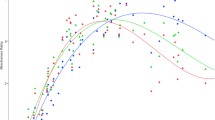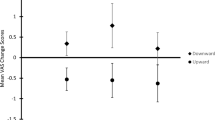Abstract
Dozens of studies have linked ideal-body media exposure to the idealization of a slim female figure, but none have examined the proportions of this figure. College women's and men's exposure to ideal-body images on television was correlated with their perceptions of the ideal female bust, waist, and hip sizes and their approval of surgical body-alteration methods. For women, exposure to ideal-body images on television predicted the choice of a smaller waist and hips, and either a larger bust (for those who perceived themselves to be smaller-busted) or a smaller bust (for those who perceived themselves to be larger-busted). For both women and men, exposure to ideal-body images on television predicted approval of women's use of surgical body-alteration methods such as liposuction and breast augmentation.
Similar content being viewed by others
RFERENCES
Barber, N. (1998). Secular changes in standards of bodily attractiveness in American women: Different masculine and feminine ideals. Journal of Psychology, 132, 87-94.
Cattarin, J. A., Thompson, J. K., Thomas, C., & Williams, R. (2000). Body image, mood, and televised images of attractiveness: The role of social comparison. Journal of Social and Clinical Psychology, 19, 220-239.
Fouts, G., & Burggraf, K. (1999). Television situation comedies: Female body images and verbal reinforcements. Sex Roles, 40, 473-481.
Fouts, G., & Burggraf, K. (2000). Television situation comedies: Female weight, male negative comments, and audience reactions. Sex Roles, 42, 925-932.
Garner, D. M., Garfinkel, P. E., Schwartz, D., & Thompson, M. (1980). Cultural expectations of thinness in women. Psychological Reports, 47, 483-491.
Gerbner, G., Gross, L., Morgan, M., & Signorielli, N. (1994). Growing up with television: The cultivation perspective. In J. Bryant & D. Zillmann (Eds.), Media effects: Advances in theory and research (pp. 17-41). Hillsdale, NJ: Erlbaum.
Gleaves, D. H., Miller, K. J., Williams, T. J., & Summers, S. A. (2000). Eating disorders: An overview. In K. J. Miller & J. S. Mizes (Eds.), Comparative treatments for eating disorders (pp. 1-49). New York: Springer.
Greenberg, B. (1988). Some uncommon television images and the drench hypothesis. Applied Social Psychology Annual, 8, 88-102.
Harrison, K. (2000). The body electric: Thin-ideal media and eating disorders in adolescents. Journal of Communication, 50, 119-143.
Harrison, K., & Cantor, J. (1997). The relationship between media consumption and eating disorders. Journal of Communication, 47, 40-67.
Henderson-King, E., & Henderson-King, D. (1997). Media effects on women's body esteem: Social and individual difference factors. Journal of Applied Social Psychology, 27, 399-417.
Irving, L. M. (1990). Mirror images: Effects of the standard of beauty on the self-and body-esteem of women exhibiting varying levels of bulimic symptoms. Journal of Social and Clinical Psychology, 9, 230-242.
Jourard, S. M., & Secord, P. F. (1955). Body-cathexis and personality. British Journal of Psychology, 46, 130-138.
Katch, V. L., Campaigne, B., Freedson, P., Sayd, S., Katch, F. L., & Behnke, A. R. (1980). Contribution of breast volume and weight to body fat distribution in females. American Journal of Physical Anthropology, 53, 93-100.
Kenrick, D. T., & Gutierres, S. E. (1980). Contrast effects and judgments of physical attractiveness: When beauty becomes a social problem. Journal of Personality and Social Psychology, 38, 131-140.
Koff, E., & Benavage, A. (1998). Breast size perception and satisfaction, body image, and psychological functioning in Caucasian and Asian American college women. Sex Roles, 38, 655-673.
McCreary, D. R., & Sadava, S. W. (1999). Television viewing and self-perceived health, weight, and physical fitness: Evidence for the cultivation hypothesis. Journal of Applied Social Psychology, 29, 2342-2361.
Sherwood, L. (1993). Human physiology: From cells to systems. St. Paul, MN: West Publishing.
Silverstein, B., Perdue, L., Peterson, B., & Kelly, E. (1986). The role of the mass media in promoting a thin standard of attractiveness for women. Sex Roles, 14, 519-532.
Silverstein, B., Perdue, L., Peterson, B., Vogel, L., & Fantini, R. (1986). Possible causes of the thin standard of bodily attractiveness for women. International Journal of Eating Disorders, 5, 907-916.
Spitzer, B. L., Henderson, K. A., & Zivian, M. T. (1999). Gender differences in population versus media body sizes: A comparison over four decades. Sex Roles, 40, 545-565.
Stice, E., Schupak-Neuberg, E., Shaw, H. E., & Stein, R. I. (1994). Relation of media exposure to eating disorder symptomatology: An examination of mediating mechanisms. Journal of Abnormal Psychology, 103, 836-840.
Stice, E., & Shaw, H. E. (1994). Adverse effects of the media portrayed thin-ideal on women and in kages to bulmic symptomatology. Journal of Social and Clinical Psychology, 13, 288-308.
Stunkard, A. J., Sorensen, T. I., & Schulsinger, F. (1983). Use of the Danish Adoption Register for the study of obesity and thinness. In S. Kety (Ed.), The genetics of neurological and psychiatric disorders (pp. 115-120). New York: Raven.
Turner, S. L., Hamilton, H., Jacobs, M., Angood, L. M., & Dwyer, D. H. (1997). The influence of fashion magazines on the body image satisfaction of college women: An exploratory analysis. Adolescence, 32, 603-614.
Wiseman, C. V., Gray, J. J., Mosimann, J. E., & Ahrens, A. H. (1992). Cultural expectations of thinness in women: An update. International Journal of Eating Disorders, 11, 85-89.
Author information
Authors and Affiliations
Corresponding author
Rights and permissions
About this article
Cite this article
Harrison, K. Television Viewers' Ideal Body Proportions: The Case of the Curvaceously Thin Woman. Sex Roles 48, 255–264 (2003). https://doi.org/10.1023/A:1022825421647
Issue Date:
DOI: https://doi.org/10.1023/A:1022825421647




